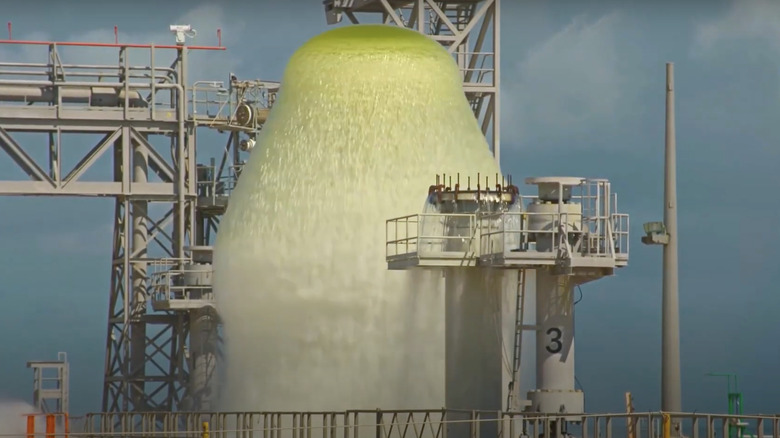Why NASA Releases 450,000 Gallons Of Water During A Rocket Launch
When you think of a rocket launch, you likely imagine a massive explosion of flames and smoke expanding across the launch site as the propulsion systems hurl thousands of tons of metal into space. What few probably don't realize is the fact that there is also a small waterfall pumped out beneath the rocket before liftoff. Just moments before launch, NASA can release up to 450,000 gallons of water, which is roughly two-thirds the amount that fills an Olympic-sized swimming pool.
This water is necessary because the noise produced during liftoff is unimaginably loud. We're talking about a wall of sound that can top 200 decibels, which is far louder than a jet engine or a thunderclap. In addition to the heat produced by the launch, the sound itself is powerful enough to shake electronics into failure or tear apart pieces of the rocket. That's why NASA developed its sound suppression system, which floods the launchpad with an enormous amount of water designed to absorb those sound waves before they cause damage.
Of course, the launch isn't cheap. NASA pays huge amounts to go to space, and this is just another part of that expense. But NASA's sound suppression system is absolutely imperative to mission safety. As rockets get bigger, louder, and more powerful, NASA continues to upgrade the system, like in recent Artemis tests, to ensure future missions withstand those first brutal seconds on the pad.
How does NASA's sound suppression system work?
Seconds before launch, an enormous surge of water is unleashed from massive holding tanks, flooding the base of the rocket. In recent tests of NASA's Space Launch System, 450,000 gallons of water were released in under a minute. The heat from burning fuel in the rocket engine instantly vaporizes the water, creating a thick cloud of steam that completely covers the launch pad. This can reduce the sound produced in the launch to about 140 decibels, which is still painful to the ears but is about the same loudness of a jet engine. However, it's not just the sound that the water is dampening. It's also mitigating immense amounts of heat that are produced during takeoff.
Rocket launches are violent. The tremendous heat released from the boosters' can reach 6,000 degrees Fahrenheit, and the high temperatures can linger on the launchpad well after the rocket has launched. We're talking about rocket boosters that consume fuel at a rate more than 2 million times that of a standard car. Without intervention, that heat could start fires or warp critical infrastructure. The water system helps prevent all of these hazards from occurring. This deluge system is an unsung hero in an otherwise thunderous spectacle. It ensures the most important satellite launches and space expeditions can continue to push the boundaries of space exploration.

